The Samsung SM843 takes over from the PM830 as the entry and mainstream enterprise-class SSD designed for use in situations that tend to be read-intensive like compute server boot drives, higher-end client workstation needs, and certain embedded applications. The drive utilizes a SATA interface, offers a slim 7mm drive height, and leverages an in-house Samsung 20nm MLC NAND as well as a Samsung controller and firmware stack. To allay concerns, the SM843 offers write endurance of 1PB (1000TB). Design-wise, the SM843 looks much like its client-focused cousin, the 840 Pro, however the core differences are added over-provisioning in the SM843 to show higher endurance and a firmware that’s tuned for workloads that are more read-heavy.
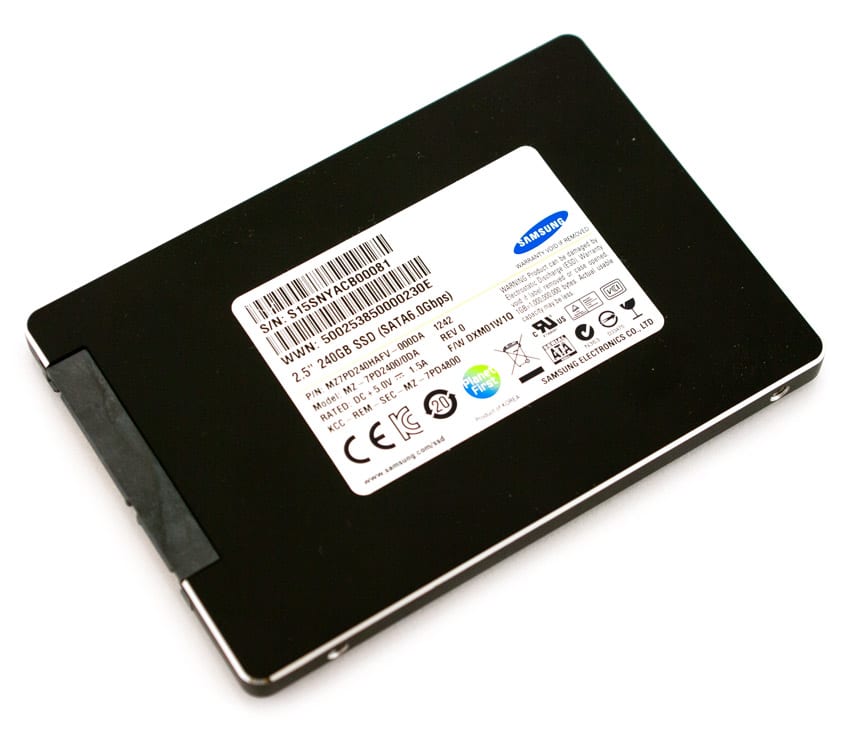
In essence, Samsung’s SM843 addresses a bit of a grey area in the enterprise SSD space – the room where we see client SSDs working their way into enterprise applications like flash arrays and servers. In this particular slice of the enterprise market, cost is generally a core driver in the buying decision, which leads many buyers down the path to client SSDs. However, now Samsung and other storage vendors are shifting their product lines to create solutions tailored for these needs that will help them take back the market. At the same time, they are providing a little more coverage in terms of endurance and attempting to keep pricing as close to the client SSD alternatives as possible.
The SM843 rides alongside the SM1625, but while the SM843 is built for read-intensive needs, the SM1625 is purposed for write-intensive operations. The SM1625 comes with two SAS 6 Gbit/s connectors that can be combined for bandwidth reaching 12 Gbit/s. The SM1625 also has capacities at 100GB, 200GB, 400GB, and 800 GB.
Riding alongside the new SM1625 high-end SAS drive, the Samsung SM843 comes in capacities of 120GB, 240GB, and 480GB and is available now. Our review model is the 240GB capacity.
Samsung SM843 Specifications
- Capacities
- 120GB (MZ7PD120HAFV)
- 240GB (MZ7PD240HAFV)
- 480GB (MZ7PD480HAGM)
- Sequential R/W (MB/s): 530/420
- Random R/W (IOPs): 70,000/11,500
- 20nm Samsung MLC NAND
- Samsung MDX S4LN021X01-8030 Controller
- Form factor: 2.5", 7mm
- Host interface: SATA 3.0 – 6Gb/s
- Encryption: AES-256
- MTBF: 2 million hours
- Uncorrectable bit: 1 in 1017
- Power
- Active Read:2.7W
- Active Write: 3.4W
- Idle: 0.3W
- Write endurance (TBW): 1PB
- Physical dimensions: 100mm x 69.85mm x 7mm
- Weight: 56g
Build and Design
The design of the new Samsung SM843 light-enterprise SSD is based on the same body as the consumer-targeted SSD 840 and 840 Pro. The SM843 sports an updated look from the PM830, but one that very much builds on Samsung’s tradition of simple, clear labeling. The drive features a brushed metal top, while the bottom features a label with key information about the drive. The SM843 offers LED support for visual drive monitoring in data center applications.
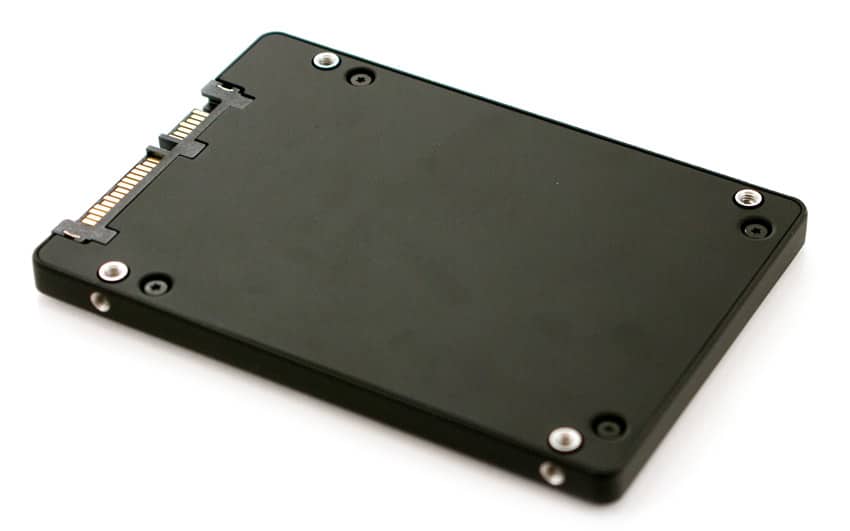
A better-protected SATA interface connector is one of the SM843’s design enhancements compared to the PM830. The body is also better designed, which unlike the PM830 that used internal plastic clips to hold together its chassis, features standard screws to hold the body together. This allows for easier servicing and a better appearance.
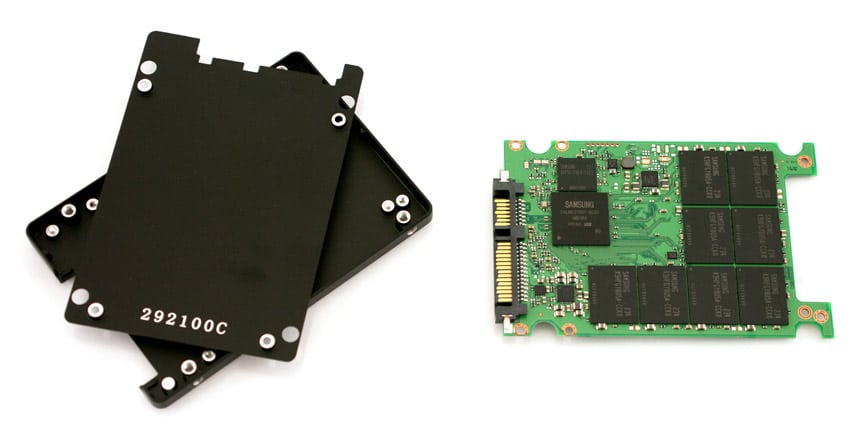
There are significant changes from the layout of the PM830’s circuit board. The SM843 uses the new Samsung MDX S4LN021X01-8030 controller with 256MB 2x-nm class DDR2 toggle-mode DRAM from a K4P4G324EB-FGC2 module.
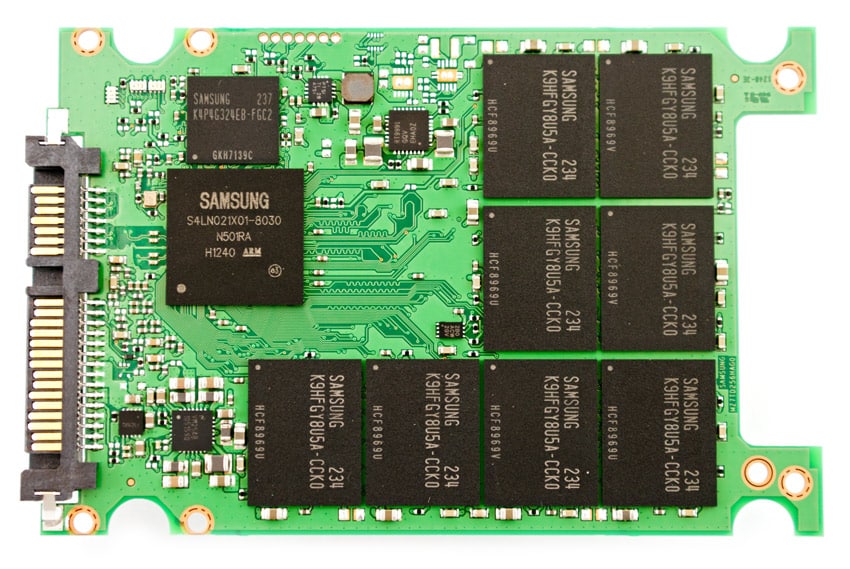
Storage is provided by eight 2x-nm 32GB Samsung K9HFGY8U5A-CCK0 NAND modules, which is slightly over-provisioned to offer a 240GB unformatted capacity.
Testing Background and Comparables
The Samsung SM843 uses Samsung 20nm MLC NAND and a Samsung MDX S4LN021X01-8030 controller with a SATA 6.0Gb/s interface.
Comparables for this review:
- Intel SSD DC S3700 (200GB, Intel PC29AS21CA0 controller, Intel 25nm HET MLC NAND, 6.0Gb/s SATA)
- Samsung SSD 840 Pro (512GB, 300mhz Samsung 3-core MCX controller, Samsung 2x nm Toggle NAND Flash, 6.0Gb/s SATA)
- Micron P400e (200GB, Marvell 9174 controller, Micron 25nm MLC NAND Flash, 6.0Gb/s SATA)
- Intel SSD 520 (240GB, SandForce SF-2500 controller, Intel 25nm MLC NAND Flash, 6.0Gb/s SATA)
- Intel SSD 320 (300GB, Intel PC29AS21BA0 controller, Intel 25nm MLC NAND Flash, 6.0Gb/s SATA)
We rarely take the time to discuss why comparable drives are selected in individual reviews, as the process is generally pretty intuitive. In this case however, the SM843 addresses a market that is not well defined. We often see consumer SSDs being deployed in enterprise environments. Pure Storage for instance has used the Samsung 830, Whiptail has used the Intel SSD 320 and Micron m4, and hybrid arrays frequently pop up in the lab or on the tradeshow floor with Intel SSD 320s, SSD 520s and a variety of other client-based offerings. Enterprise arrays typically go to these client drives because they’re comparatively inexpensive and "reliable enough" to get the job done; if a drive fails, toss it and drop in another. It’s also important to remember that these SSDs are being used in scenarios where the rest of the data is often on hard drives, so even consumer drives paired with a software management layer provide a reasonable bump in performance, even if that performance is well below more expensive enterprise-grade SSDs. So while the SM843 lacks few obvious competitors, there are several client-based drives in the mix as well that play in this space. This read intensive low-end enterprise market will however see increasing competition. Micron is nearing the release of their next-generation drive for this space, and we’ve heard from other storage vendors that creating a low-cost enterprise drive is definitely on the roadmap.
All SAS/SATA enterprise SSDs are benchmarked on our second-generation enterprise testing platform based on a Lenovo ThinkServer RD630. This new Linux-based testing platform includes the latest interconnect hardware such as the LSI 9207-8i HBA as well as I/O scheduling optimizations geared towards best-case flash performance. For synthetic benchmarks, we utilize FIO version 2.0.10 for Linux and version 2.0.12.2 for Windows.
- 2 x Intel Xeon E5-2620 (2.0GHz, 15MB Cache, 6-cores)
- Intel C602 Chipset
- Memory – 16GB (2 x 8GB) 1333Mhz DDR3 Registered RDIMMs
- Windows Server 2008 R2 SP1 64-bit, Windows Server 2012 Standard, CentOS 6.3 64-Bit
- 100GB Micron RealSSD P400e Boot SSD
- LSI 9211-4i SAS/SATA 6.0Gb/s HBA (For boot SSDs)
- LSI 9207-8i SAS/SATA 6.0Gb/s HBA (For benchmarking SSDs or HDDs)
- Mellanox ConnectX-3 10GbE PCIe 3.0 Adapter
- Mellanox ConnectX-3 InfiniBand PCIe 3.0 Adapter
Enterprise Synthetic Workload Analysis
Flash performance varies throughout the preconditioning phase of each storage device. Our enterprise storage benchmark process begins with an analysis of the way the drive performs during a thorough preconditioning phase. Each of the comparable drives are secure erased using the vendor’s tools, preconditioned into steady-state with the same workload the device will be tested with under a heavy load of 16 threads with an outstanding queue of 16 per thread, and then tested in set intervals in multiple thread/queue depth profiles to show performance under light and heavy usage.
Preconditioning and Primary Steady-State Tests:
- Throughput (Read+Write IOPS Aggregate)
- Average Latency (Read+Write Latency Averaged Together)
- Max Latency (Peak Read or Write Latency)
- Latency Standard Deviation (Read+Write Standard Deviation Averaged Together)
Our Enterprise Synthetic Workload Analysis includes four profiles based on real-world tasks. These profiles have been developed to make it easier to compare to our past benchmarks as well as widely-published values such as max 4K read and write speed and 8K 70/30, which is commonly used for enterprise drives. We also included two legacy mixed workloads, the traditional File Server and Webserver, each offering a wide mix of transfer sizes.
- 4K
- 100% Read or 100% Write
- 100% 4K
- 8K 70/30
- 70% Read, 30% Write
- 100% 8K
- File Server
- 80% Read, 20% Write
- 10% 512b, 5% 1k, 5% 2k, 60% 4k, 2% 8k, 4% 16k, 4% 32k, 10% 64k
- Webserver
- 100% Read
- 22% 512b, 15% 1k, 8% 2k, 23% 4k, 15% 8k, 2% 16k, 6% 32k, 7% 64k, 1% 128k, 1% 512k
Our first test measured 100% 4K random write performance with a load of 16T/16Q. In this setting, the bursting nature of the Samsung SM843 shines through clearly, with the highest peak transfer speed in the group measuring 62,000 IOPS, which then leveled off near 12,500 IOPS as it entered steady-state. While not as strong as the Micron P400m or Intel DC S3700 which are geared towards higher levels of write activity, it still came in aligned with Samsung’s spec-sheet that claimed 11,500 IOPS 4K write.
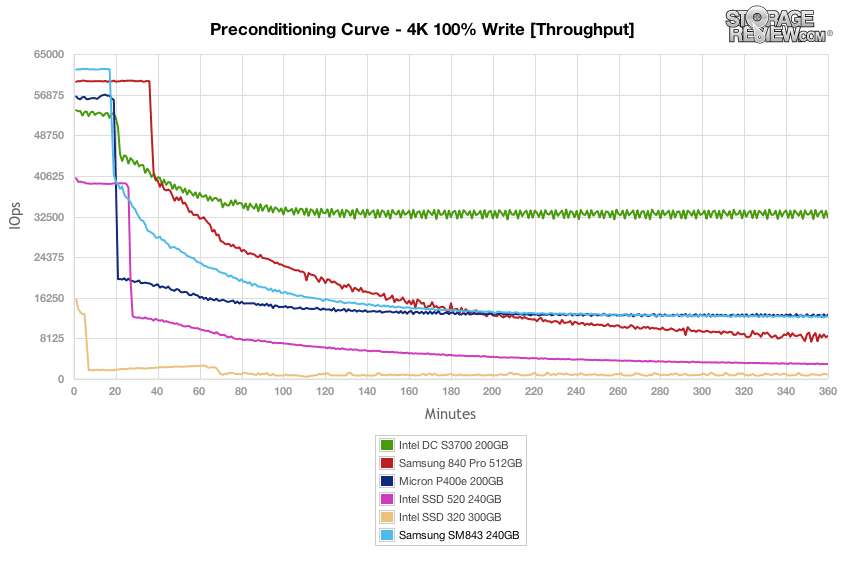
With a heavy 16T/16Q load, the Samsung SM843 measured 4.1ms in burst and then lowly scaled up to 20.5ms as it neared steady-state.
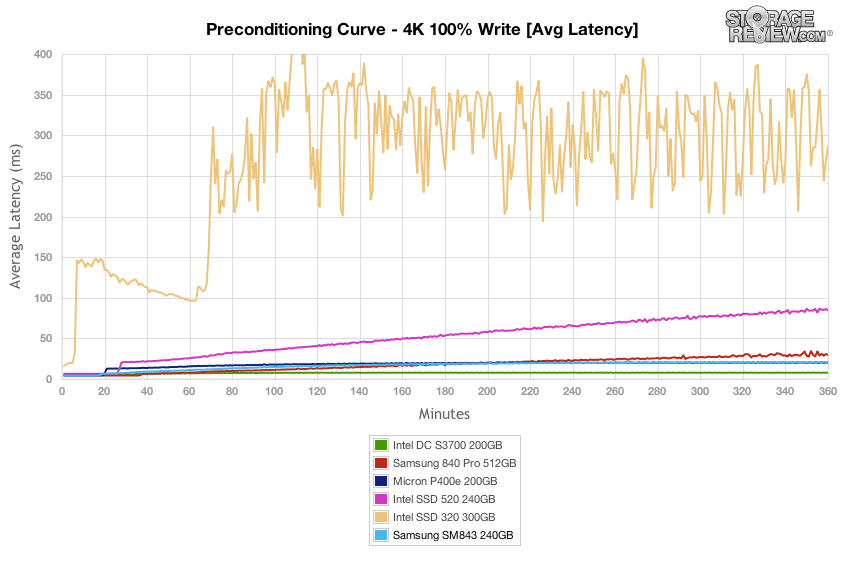
Comparing max latency between each SSD, the Samsung SM843 with its minimal over-provisioning levels had similar max response times as the consumer-focused SSD 840 Pro, which ranged between 400-750ms in steady-state.
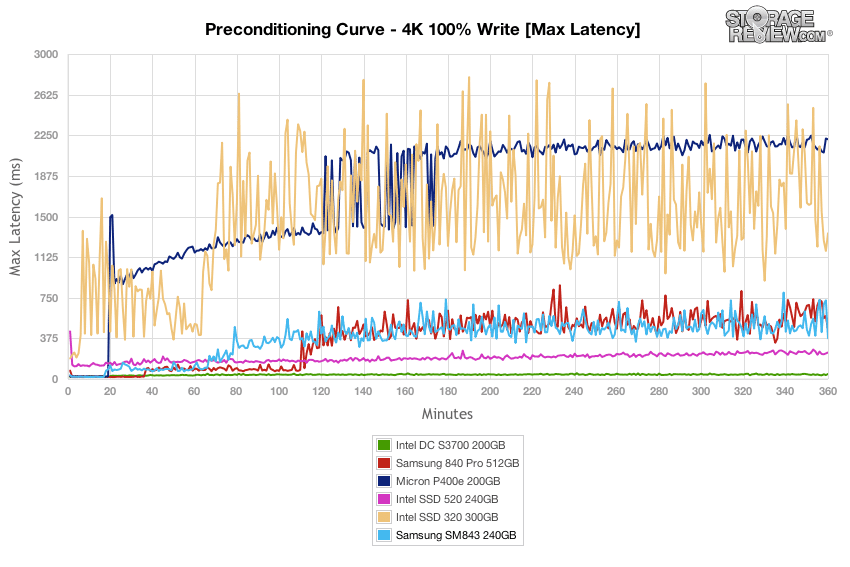
Diving in further to the latency consistency in our 4k random write workload, the Samsung SM843 edged out the SSD 840 Pro with its higher over-provisioning, but couldn’t keep up with the more write-oriented enterprise SSD.
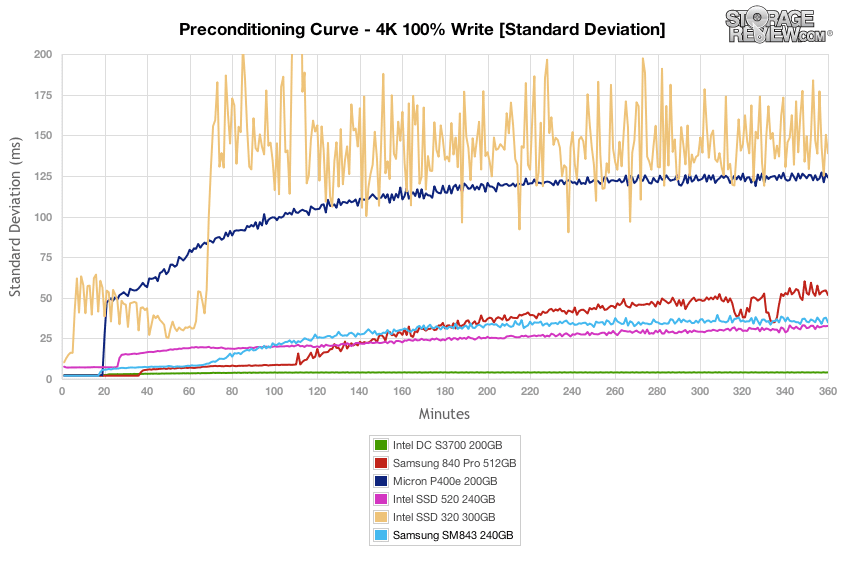
After 6 hours of preconditioning, the Samsung SM843 offered the second highest 4K random read performance, coming in under the 512GB 840 Pro. In write performance, it came in second behind the Intel DC S3700.
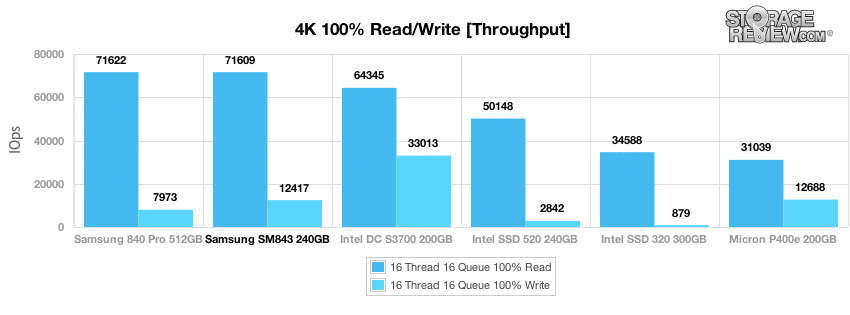
With a heavy load of 16T/16Q, the Samsung SM843 and SSD 840 Pro offered the lowest read latency out of the group we compared, measuring just 3.57ms. Its average write latency though slipped higher than the write-targeted enterprise SSD with a time of 20.61ms.
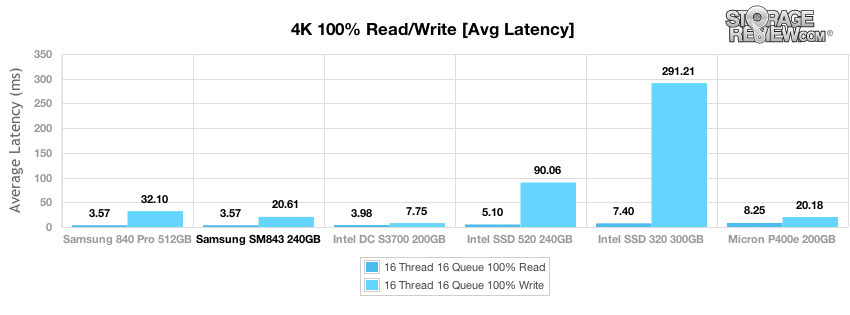
As we look at max latency in our 4k test, its important to note that a key contributing factor to lower peak write latency is increased over-provisioning. In 100% read activity, the Samsung SM843 measured 21.8ms peak, while its steady-state peak write latency measured a much steeper 700.9ms.
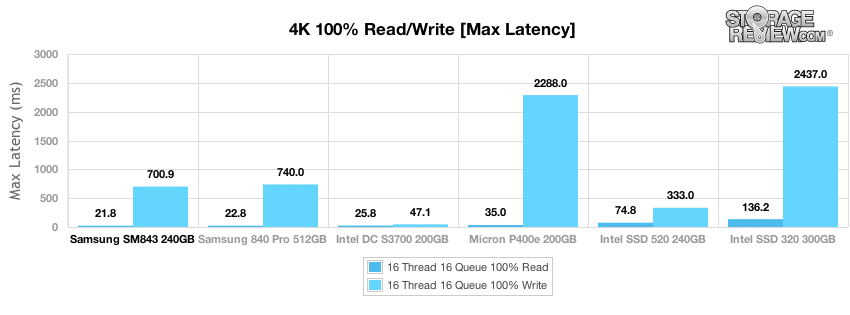
The added OP compared to the consumer-focused SSD 840 Pro helped the SM843 keep write latency standard deviation lower by comparison, but it still came up higher than the Intel DC S3700 geared towards increased write activity.
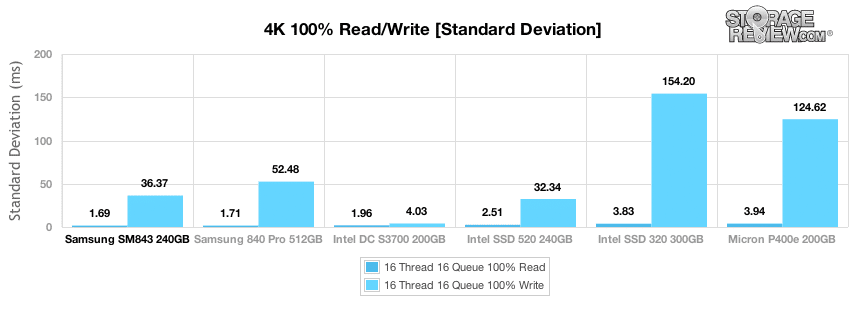
In our first mixed workload using an 8K profile 70/30% read/write spread and a constant 16T/16Q load, we measured a peak rate of 41,000 IOPS from the SM843, before it tapered off to a steady-state speed of 14,000 IOPS.
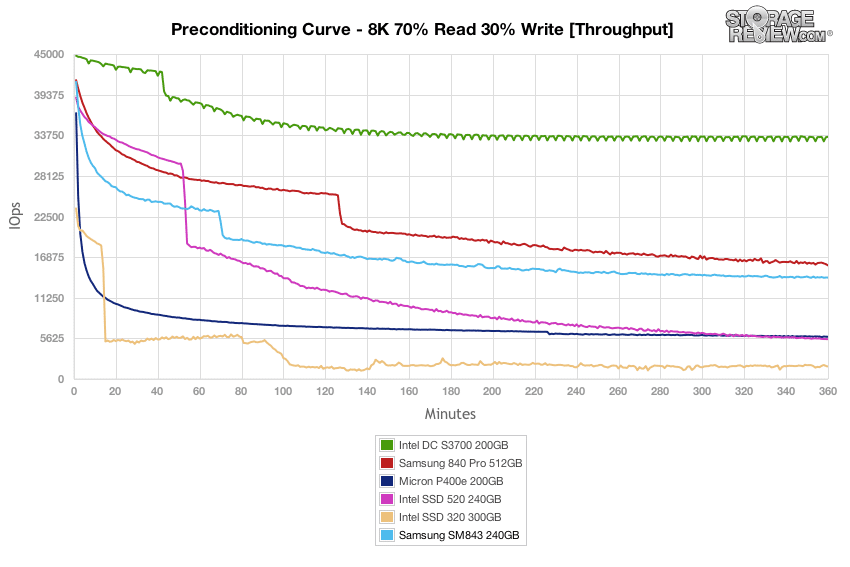
With a load of 16T/16Q, the Samsung SM843 offered an average latency of around 6.5ms in burst before increasing to 18.2ms as it neared steady-state.
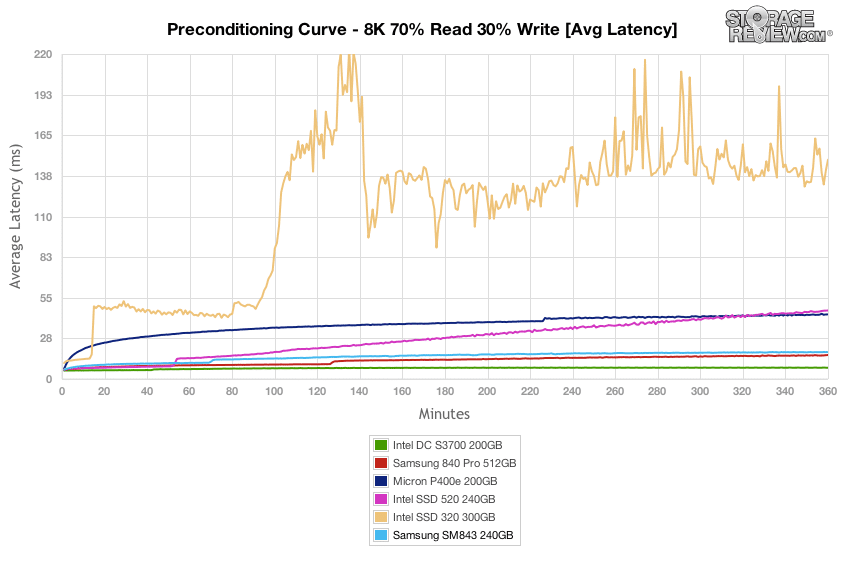
In the max latency section of our 8k 70/30 preconditioning test, the SM843 performed in the middle of the pack, measuring between 80-120ms in steady-state.
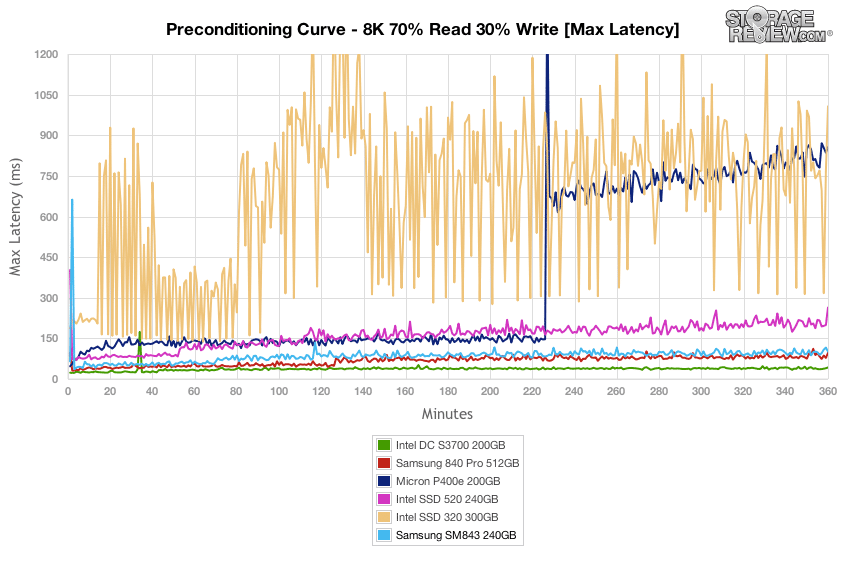
Comparing latency consistency in the entry-enterprise SSD category, the Samsung SM843 slipped towards the bottom of the pack, although it was able to show improvement over the SSD 840 Pro with its added OP.
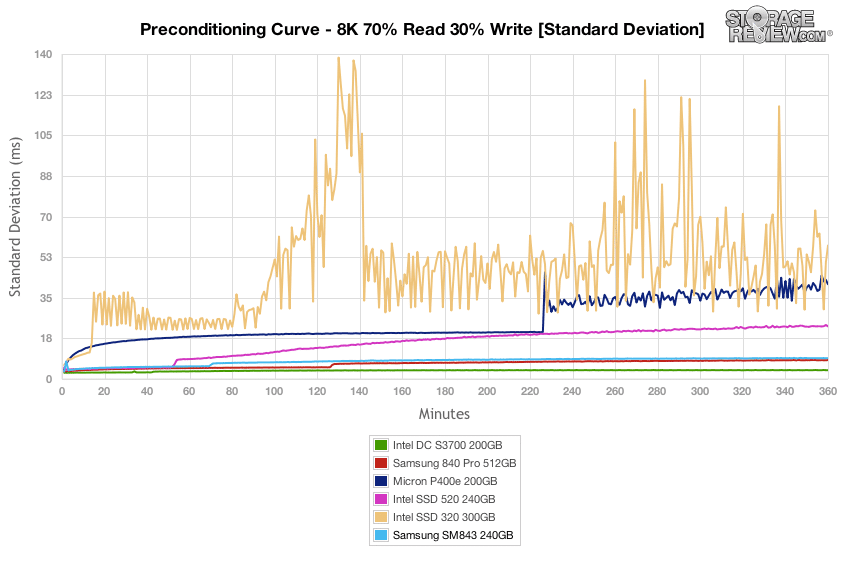
Compared to the fixed 16 thread 16 queue max workload we performed in the 100% 4K write test, our mixed workload profiles scale the performance across a wide range of thread/queue combinations. In these tests we span workload intensity from 2 threads and 2 queue up to 16 threads and 16 queue. In the expanded 8K 70/30 test, the Samsung SM843 scaled from 6,547 IOPS at 2T/2Q and peaked at 14,020 IOPS at 16T/16Q.
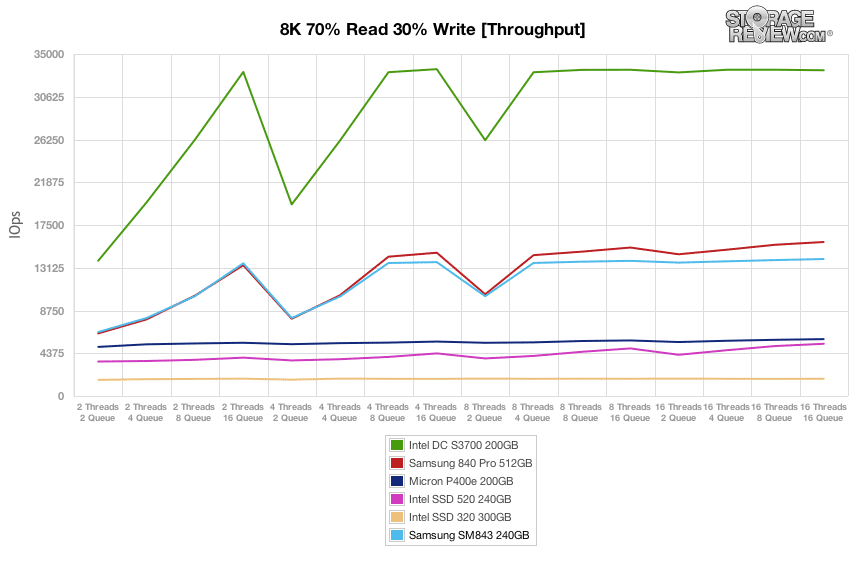
After the SSD had entered steady-state in our 8k 70/30 test, the SM843 had an average latency of 0.6ms at 2T/2Q which increased to 18.25ms at 16T/16Q.
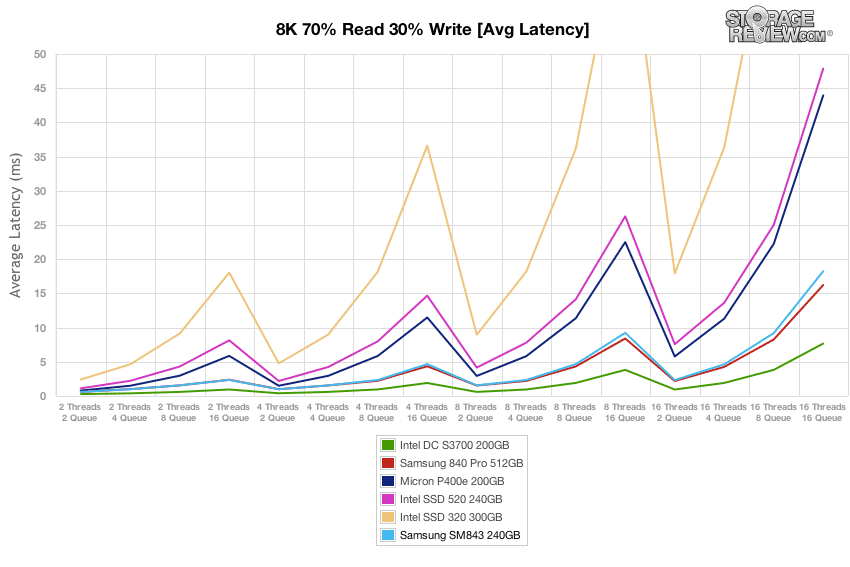
Max latency remained middle of the pack for the Samsung SM843 in our 8k 70/30 test measuring about 20ms for workloads between 2T/2Q through 16T/8Q. At 16T/16Q though, latency spiked to 137ms.
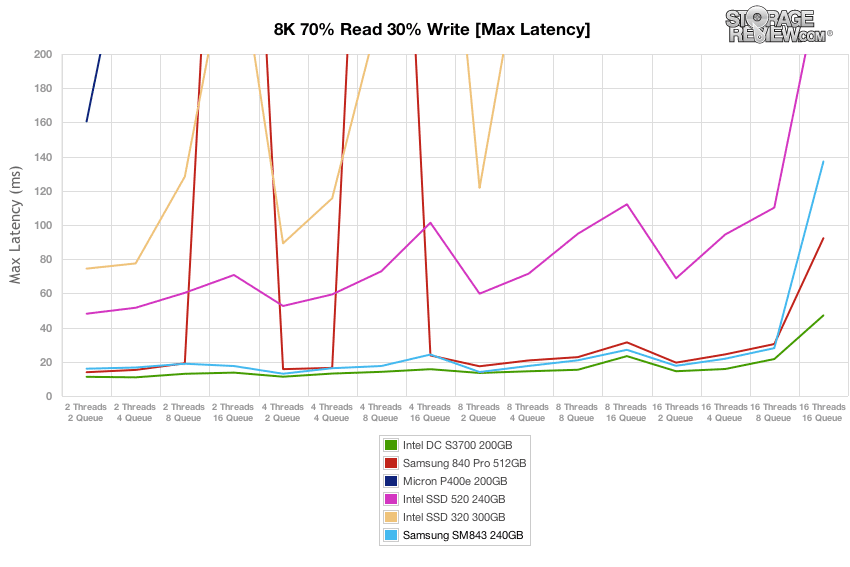
Comparing latency consistency in our 8k 70/30 test, the Samsung SM843 stayed close to the Micron and Intel entry-enterprise SSDs, going as far as edging out the P400m in all areas except 16T/16Q.
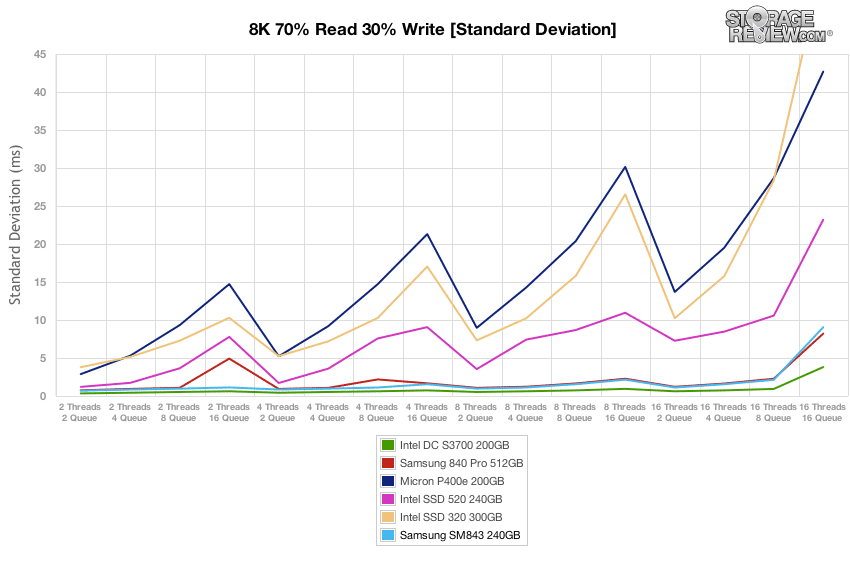
The next workload is our File Server profile, which covers a wide range of transfer sizes spanning from 512b to 512K. With a heavy 16T/16Q saturation load, the Samsung SM843 offered peak transfer speeds measuring 31,000 IOPS before tapering off to a steady-state speed near 11,000 IOPS.
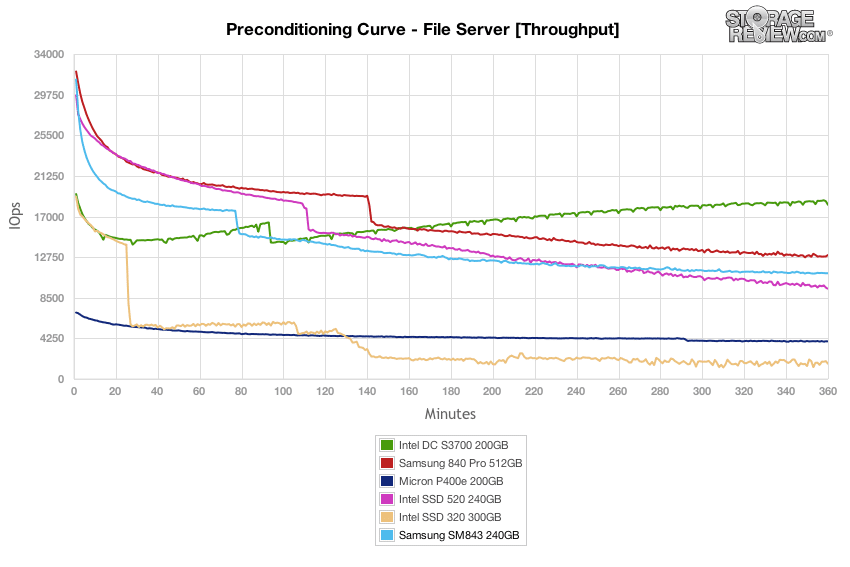
Average latency from the Samsung SM843 in our File Server preconditioning test measured 8ms in burst, before increasing to 23ms in steady-state.
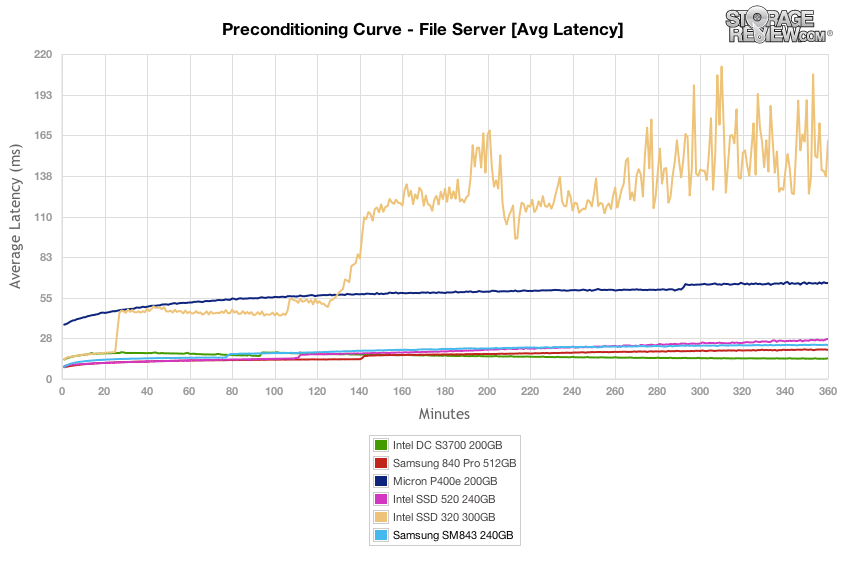
As the Samsung SM843 neared steady-state in our File Server preconditioning test, max latency ranged from 120 to just under 200ms.
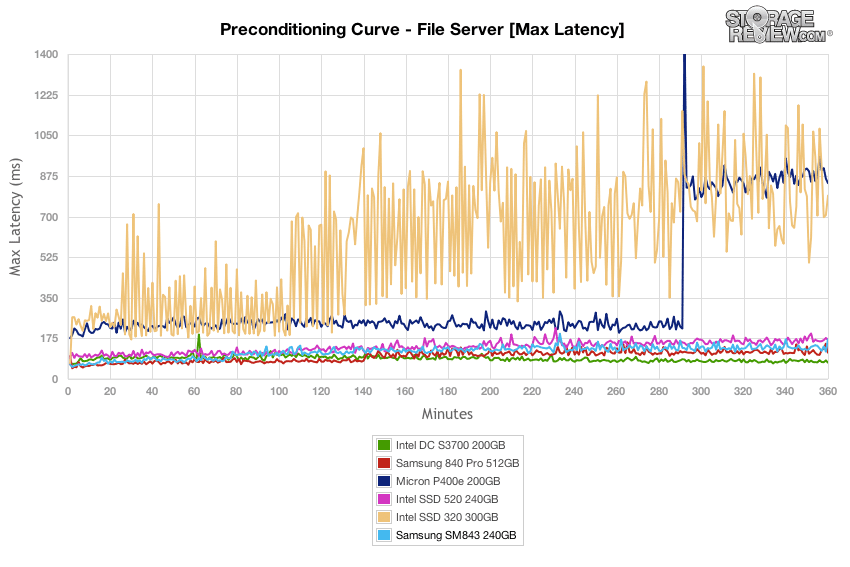
Switching focus to latency consistency in our File Server preconditioning test, the Samsung SM843 scored towards the middle of the pack, behind the SSD 840 Pro and Intel DC S3700.
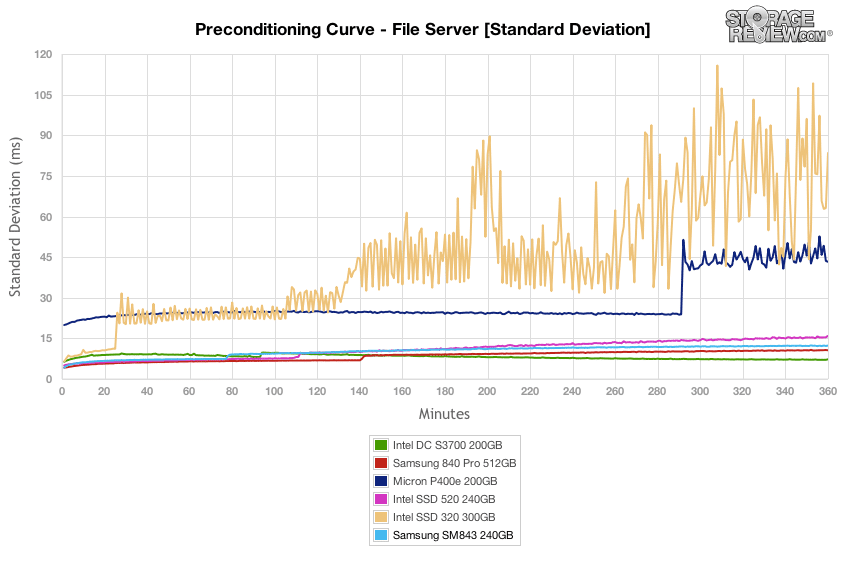
After our 6-hour File Server preconditioning process had finished on each SATA SSD, we transitioned to varied workloads where we scale between 2T/2Q up to 16T/16Q. The Samsung SM843, with its much lower amounts of over-provisioning, ranked towards the middle of the pack scaling from 5,005 IOPS at 2T/2Q and peaking at 10,981 IOPS at 16T/16Q.
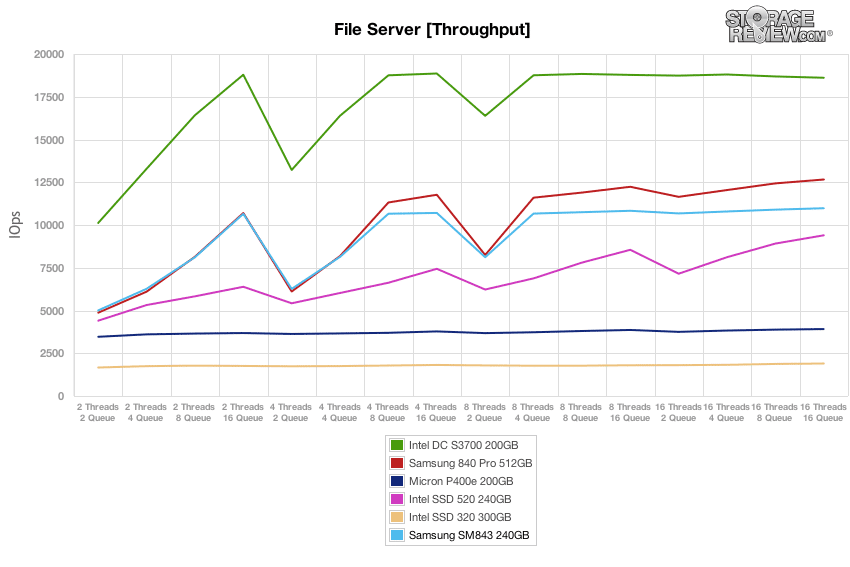
Average latency from the Samsung SM843 in our File Server test scaled between 0.79ms at 2T/2Q and increased to 23.3ms at 16T/16Q.
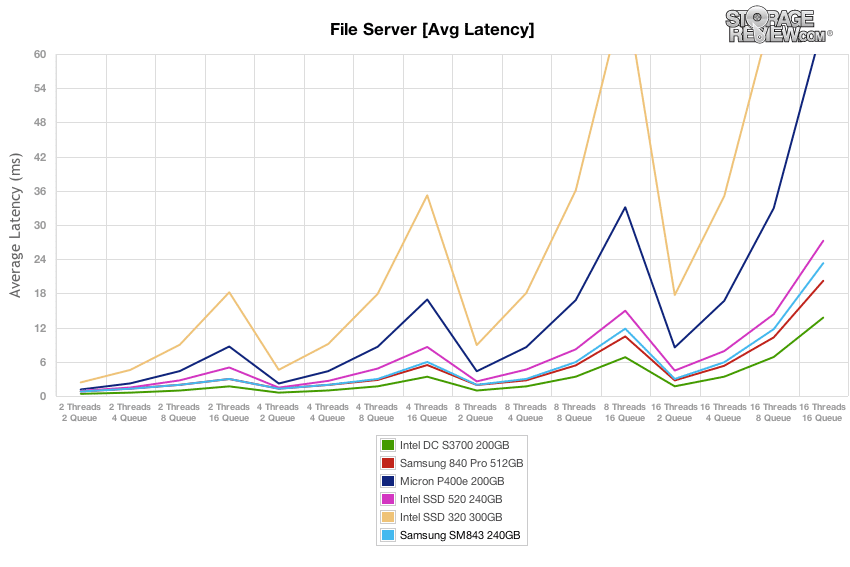
In our File Server test, the Samsung SM843 kept its peak response times fairly low across the scaling workloads, ranging around 30ms up until 16T/16Q where it peaked at 177ms. This put it in line with the Intel and consumer Samsung comparables.
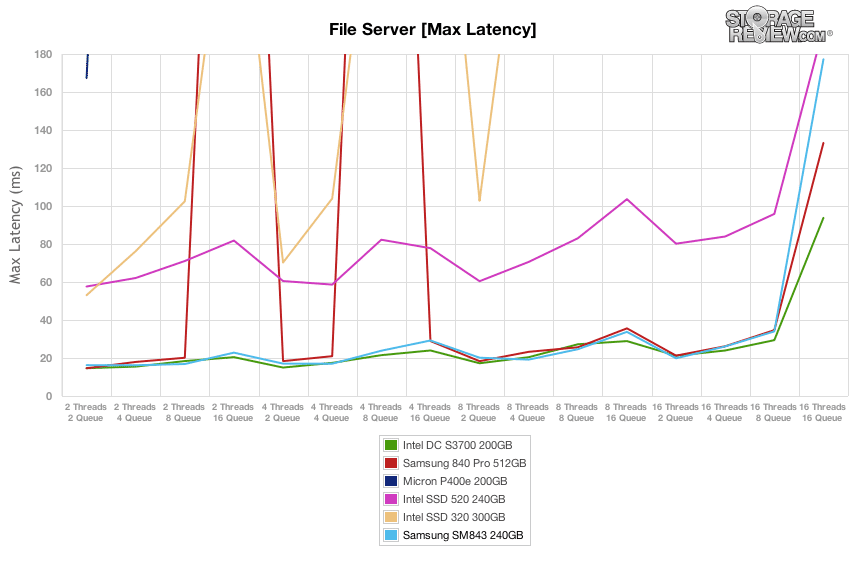
Comparing latency consistency, even with lower amounts of over-provisioning, the Samsung SM843 was able to stay close to the Intel DC S3700 across most areas except 16T/16Q.
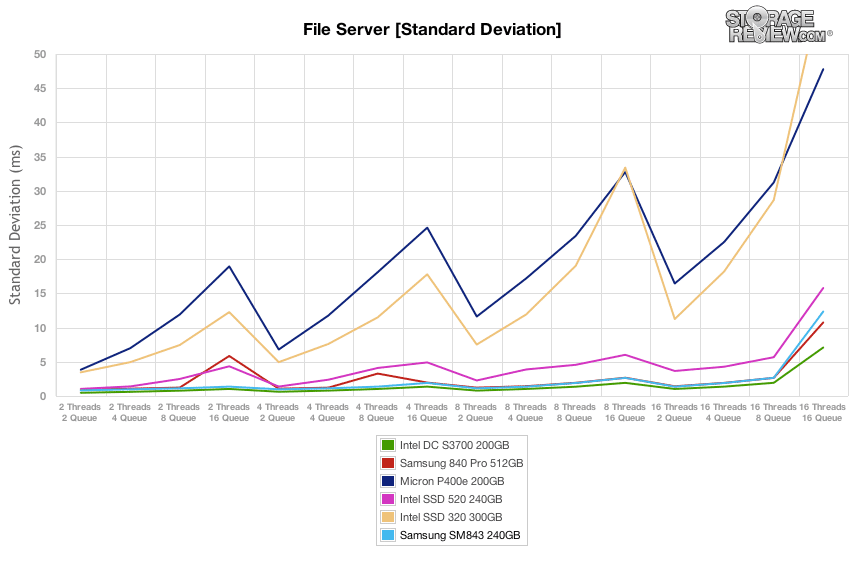
Our final preconditioning workload takes the traditional 100% read activity Web Server test and flips it to 100% write to precondition each SSD. This is our most aggressive workload, although it doesn’t really match any real-world conditions with 100% write. In this section the Samsung SM843 offered the highest burst speed out of any of the entry-enterprise SSDs and tapered out towards the middle of the pack as it neared steady-state.
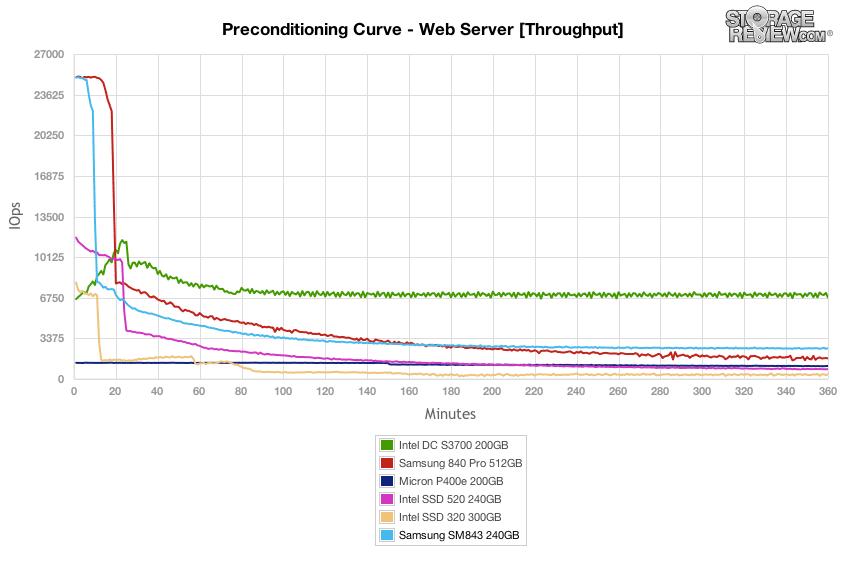
Average latency in our Web Server preconditioning test leveled off around 100ms as the drive neared steady-state, staying lower than the SSD 840 Pro with no over-provisioning.
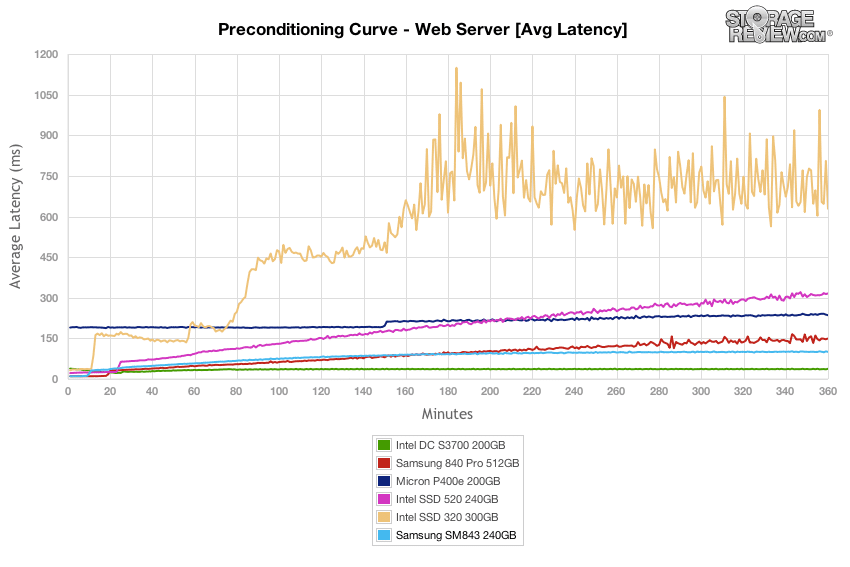
Max latency from the Samsung SM843 in our stressful 100% write Web Server preconditioning run ranged from 600 to about 1,000ms as it neared steady-state, which was higher than the other enterprise SSDs which are geared towards greater amounts of write activity.
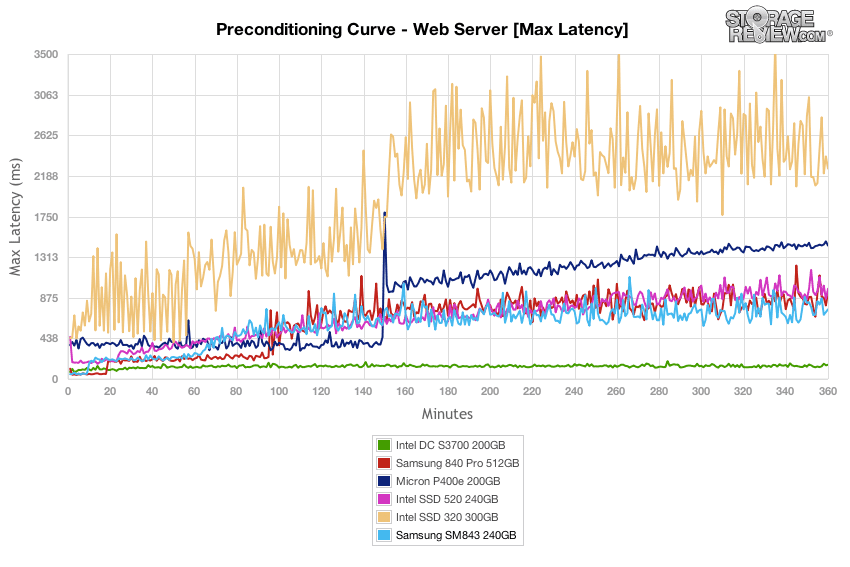
Comparing latency standard deviation in our Web Server preconditioning test, the Samsung SM843 performed better than the SSD 840 Pro without added over-provisioning.
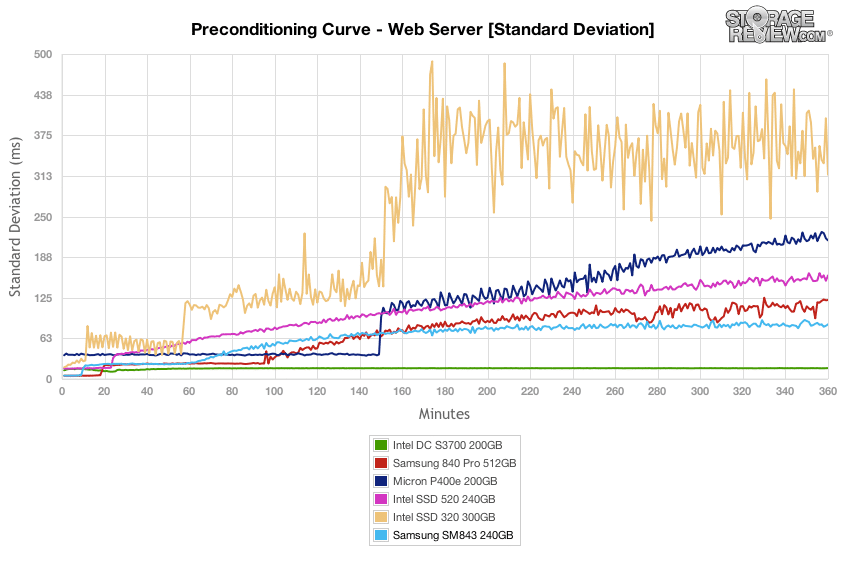
After each SSD finished our preconditioning stage in the Web Server test, we flipped the workload back to 100% read. In read-only conditions the Samsung SM843 showed its true colors and completely dominated the entry-enterprise SSD class. Performance scaled from 15,903 IOPS at 2T/2Q and increased to 27,184 IOPS at 4T/16Q. This put it well above the Intel S3700 (18.7% lead) and every other light-enterprise drive in this category.
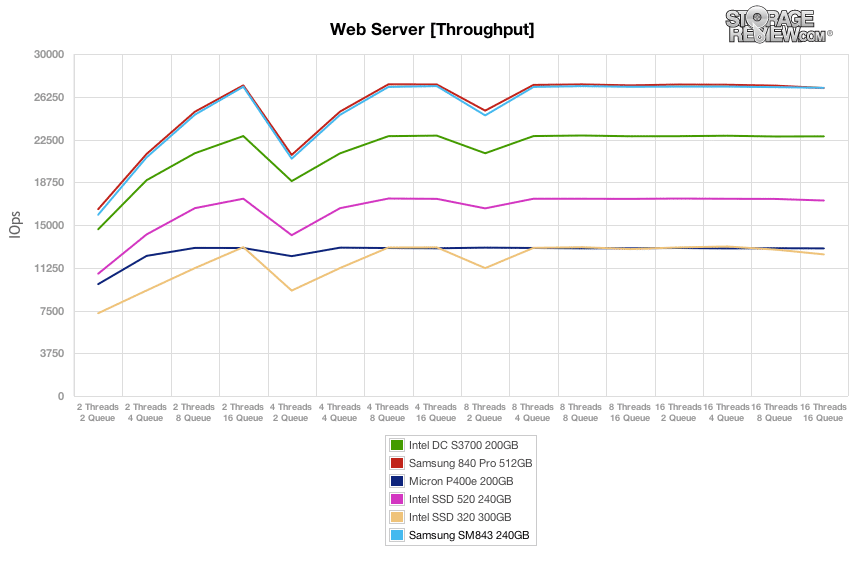
Average latency from the Samsung SM843 in our read-only Web Server scaled from 0.248ms at 2T/2Q up to 9.47ms at 16T/16Q.
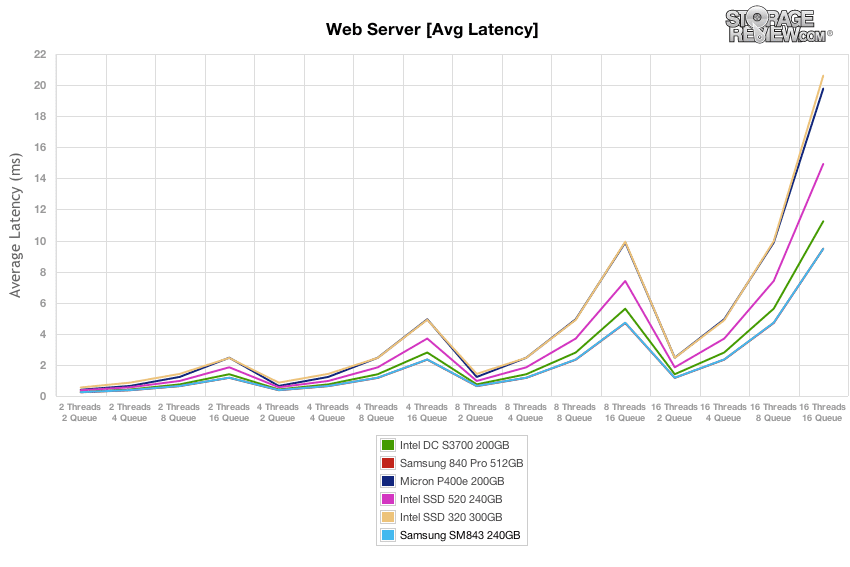
Comparing max latency in our Web Server test, the Samsung SM843 offered the lowest maximum latency measuring below 20ms, although it did spike to 113ms at 16T/16Q where the Intel SSDs were able to keep their peak response times lower.
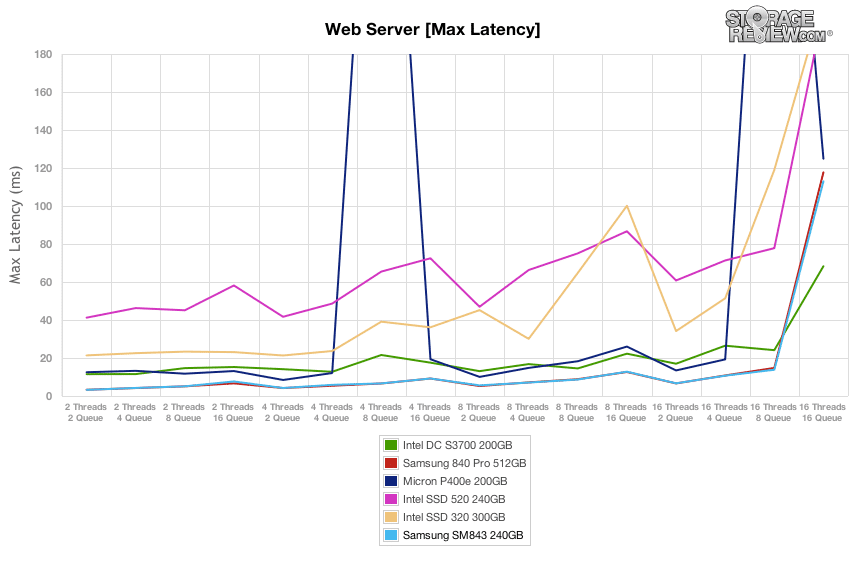
Comparing latency standard deviation in our Web Server test, the Samsung SM843 had no trouble out-pacing the rest of the light-enterprise pack with the best latency consistency.
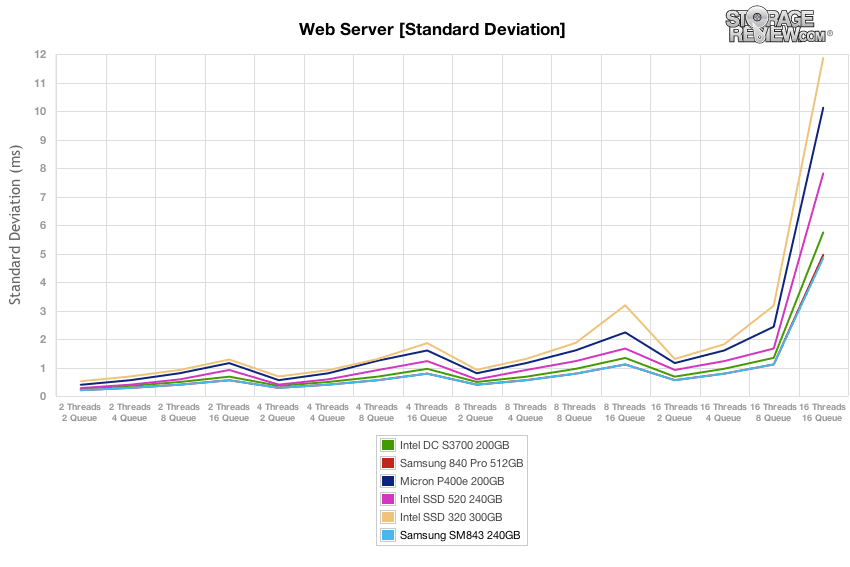
Conclusion
The Samsung SM843 fits into a unique position in the enterprise SSD market. Samsung is essentially helping to create a tier below what is generally characterized as entry-enterprise. The SM843 is a price-based value option for those who want an enterprise-built SSD that’s largely deployed in read-intensive scenarios, while still being able to offer more endurance than the client drives that often find themselves sneaking into these enterprise situations.
Compared to other client or entry-enterprise SSDs, the SM843 does very well in high read workloads for which it’s tuned, but can’t match up to a mainstream enterprise SSD. To be fair though, that’s not its purpose. Aside from read performance and endurance over client drives, the other core selling point for Samsung is price; the SM843 has a significant cost advantage versus mainstream enterprise SSDs. The SM843 comes in near $1/GB vs the $2-2.5/GB that we generally see the Intel S3700 selling for. This pricing is so low that when comparing the 240GB SM843 against the consumer 256GB SSD 840 Pro, there is roughly a $20 retail price difference which is pretty minimal. Comparing to the 200GB Intel DC S3700, buyers would need to spend roughly double what they’d spend on the Samsung, but those drives do offer much more endurance and write performance.
Switching to a performance comparison in the mainstream enterprise category, the Samsung SM843 offers about a 1/3 the write-performance of the class-leading Intel S3700. In random 4k write workloads, the SM843 clocked in at 12,417 IOPS whereas the Intel S3700 measured 33,013 IOPS. Switching to read workloads, the SM843 dominated the group. Random 4K read performance peaked at 71,609 IOPS while Intel trailed with 64,345 IOPS. In the Web Server profile the SM843 peaked at 27,184 IOPS where the Intel S3700 trailed again with 22,776 IOPS. So even when compared to a drive twice its price, the SM843 holds up well where it’s supposed to.
For environments that only require high read performance and slightly improved endurance over standard client SSDs, the Samsung SM843 is tuned perfectly for that segment with minimal cost impact over similar-capacity consumer SSDs. Compared to SSDs traditionally used in this space, including the Intel SSD 320 and 520 or the Micron P400e, the Samsung SM843 offered much higher read performance and much better mixed workload performance. Since this market segment is almost entirely dependent on cost, the attractive pricing the SM843 makes it a clear winner with the added bonus of substantially higher endurance than this segment usually offers. While the mainstream enterprise SSDs other manufacturers offer provide higher performance in write-heavy workloads, it comes at a significant cost premium, which could be hard to stomach if you don’t need the increased performance those models offer.
Pros
- Class-leading read performance
- Highest endurance in client SSD segment
- Small price premium over consumer SSDs
Cons
- Not offered in capacities above 480GB
Bottom Line
The Samsung SM843 is a purpose-built drive for enterprise environments that are very heavy in read activity with less of an endurance necessity. In this market, client SSDs have typically dominated, but Samsung brings a true enterprise-designed solution and ends up with the best drive per dollar available in this segment.




 Amazon
Amazon